Chapter 32: 2nd lone travel (II) – the violinist in Siena
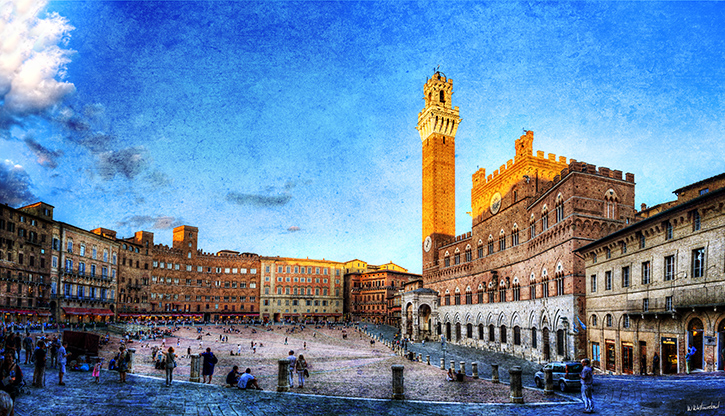
The Piazza del Campo at dusk. It is not just the shape and the concentric slope that are peculiar in this wonderful square. People actually act different. Ever seen people sun-bathing in public squares?
If you want to know what this blog is about…
Story of a soundtrack
On my last post I wrote about the days I spent in Florence. I will probably return there in some other post, but first I will tell you about other places I visited, like Siena, and the way, sometimes, unexpected happenings affect us in unexpected ways. This is the little story of my visit to Siena and of an amazingly skillful violinist who cheated me but, in exchange, presented me with one of the most beautiful melodies I have ever heard.
Siena and the Black Death
We are because we were. Both individually and globally. We cannot escape the past because, no matter how far we run from it, we still carry it with us. Our past is part of ourselves and our experiences shape us as much as our genes. For countries, for cities, it’s the same story. In the end, it’s our scars and the way we bear them that defines us, isn’t it? So happened to Siena too.
Europe, the way we know it, is obviously the result of unaccountable different events. However, one of the most enlightening turns in our history, the Renaissance, was the result of the very darkest: The Black Plague.
The Plague is believed to have entered Europe through Marseille, or Genoa, in 1348. In the following five years, the pandemic advanced an average of 2 km a day through land but also 40 km through the rivers, thus expanding from many different places at the same time in all directions, until it reached every last corner of Europe. The Black Death killed about 30-60% of the Europeans (it killed everybody in many places) and reduced the world population from some 450 million to 350-375 million, depending on the sources. Humanity would not recover its numbers in 500 years. Five-hundred-years. Hard to believe, uh?
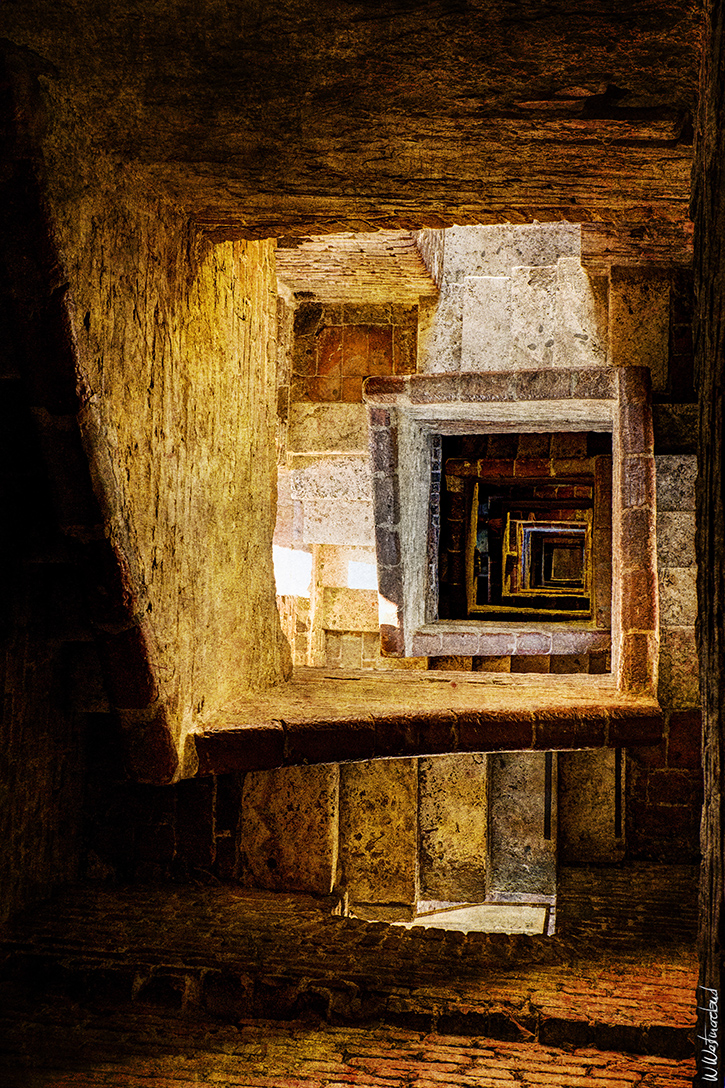
Staircase inside Torre del Mangia, Siena, Italy. Vintage version. I confess I absolutely love this pic and it will soon decorate my own home (click to see untextured version).
The Plague did not “just” kill people. It also tore to shreds the social, politic and religious tissues that had defined Europe through the Middle Ages. It killed the Medieval civilization as it was. The change was neither immediate nor easy, but it was definitive. Europe would not go back to what it had been. The Europeans didn’t die without fighting: many superstitious means, which obviously didn’t work, were developed to face the Plague; many scientific advances were also implemented. Some didn’t work, others did. The Venetians, for example, created the Quarantine, a period of 40 days in which newcomers were isolated to let the disease manifest itself before they mixed with the local population. Venice was spared the dreadful mortality rates that in some places reached 100%. The term quarantine comes from the incubation period of the disease (time elapsed between exposure to a pathogenic organism, and when symptoms are first apparent), which happens to be of 40 days. So when we use that word, we are adopting a term that the Plague created. Our past in our present.
As I was saying, the Plague made Europeans review their thoughts and believes, through utter hardship. Plagued people died hard and in great numbers. Terror spread before the disease and people fled from it. Cities were emptied, fields abandoned, crops forgotten. Famine came, crime peaked, all sorts of extremities were reached. Some became dissolute, some prayed and punished their bodies in an endless pilgrimage to nowhere, some isolated themselves and turned to cannibalism when their stores were depleted… None of these strategies worked. Society crumbled and so did faith. People began to question the civil and religious authorities. Churches were burned, monasteries and castles raided…
The Europeans came out of the Plague years somehow disappointed on, somehow freed of that fearful punishing God that had ruled the Medieval times. People were less prone to accepting that a life of hardship was due in order to go to Heaven. Mankind centered its focus on Mankind rather than in God, and on Earth before Heaven. A new joy of life, a new confidence was born of death, and Europe started the path to civil, cultural and spiritual freedom: Enter light. Enter the Renaissance.

Panoramic view of Florence in the evening. Something like this, but from further away, was my first glimpse of the Duomo when I was driving in. A touching moment (click to enlarge).
Of course, the Renaissance didn’t end with all our problems. Neither have we nowadays, but everything that we afterwards achieved, the French Revolution and its effects, the return of male democracy, the Industrial Revolution, the full democracy and the beginning of male acceptance of female equality, the civil rights and the beginning of acceptance of racial equality… all these steps come from the revolution of the Renaissance. So when you hear the word, do not think just of paintings and sculptures. Think Freedom. Freedom for all.
There is still a long way to go. Men still mistreat women, we are still a racist species (and not just the white), the strong still thread on the weak, but I believe we are in the right path. In the end, we are a gregarious predator species. It is second nature to us to help our friends, but it is also second nature to us to be hostile to the ones we do not know. Changing that is not easy.
Returning to the Plague, and to Siena, which is the reason why I started talking about the Plague in the first place… Different places were affected in different ways. Florence and Siena had been arch-rivals for ages when the pandemic hit. The years before the Black Death had witnessed Siena’s golden age, but in the years after the catastrophe, the Florentines recovered faster and, aided by the Spanish Empire, conquered Siena and ended the republic. Florence would never allow the Sienese to flourish again. That is why Florence is the heart of Renaissance and, not 50 miles away, Siena remained medieval.
That is, in a nutshell, the reason why we are so fortunate as to have those two so wonderful and different cities so close from each other, you can easily go on a day trip from one to the other.
And that I did.
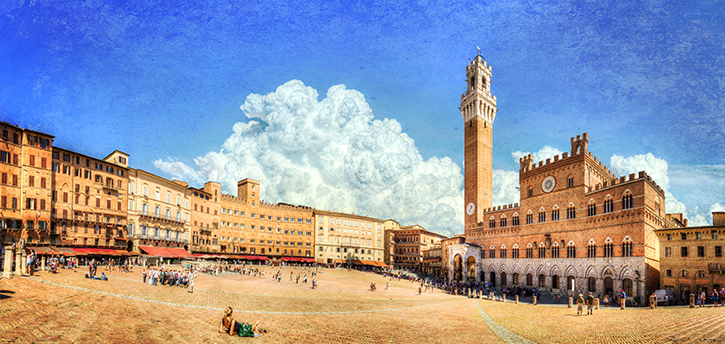
Il Campo de Siena. The most peculiar piazza in Italy, the town hall and the city tower. And yet another girl I should have talked to and asked an email so I could send her the picture (click to enlarge).
In all honesty, I did not quite enjoy Siena. As I told you in the previous post, I was not feeling so hot and I had found a safe haven of sorts in Florence. This day-trip turned out an unexpected disruption and all the time I wanted to go back. But, let it be clear, it had nothing to do with Siena; it would have happened anywhere. Siena is a beautiful old lady of elegant decadence and fiery contrast. Siena is not Florence and does not want to. I will return with a lighter spirit some day and treat her fairly. We both deserve it.
I did spend the day there, anyhow, and I did make an effort to do justice to the city. And I was actually rewarded. I didn’t enjoy Siena that day, but I do enjoy the memories and images I brought with me. I did climb up that tower and enjoyed a breathtaking view of the city and the soft hills of Tuscany surrounding her.

Piazza del Campo from the Tower. You ever heard of the Palio, the frantic horse race that takes place in Siena twice every year? It is all down here.
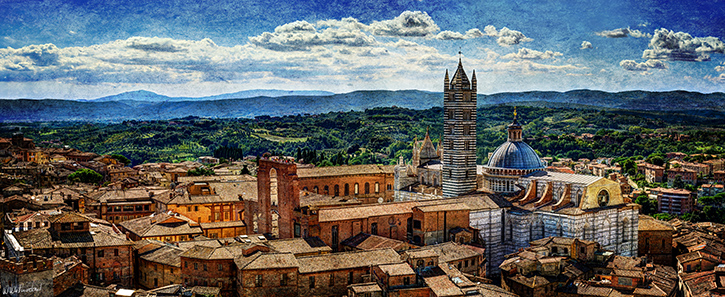
The Duomo and the soft hills of Tuscany , as seen from the Torre del Mangia, the town-hall bell tower in Siena.
Before I climbed the endless staircase to the top of the tower I wandered around the unique piazza del Campo, where people lie and sunbathe like on a beach ( I lay there for a while myself, where I shot the pic of the girl), and went as far as the Duomo before coming back. The Cathedral of Siena deserves its own post, but I still have to process most of the detail pics I shot, so will just leave it for another occasion. Covered in white and black marble, The Duomo was under construction when the Plague hit. It was meant to be huge. What you see as the main nave on the picture above was meant to be the transept (the arms of the cross that shape a classical church). The main nave would actually have covered the space from the dome to the arch you can see isolated to the left of the building. Huge.
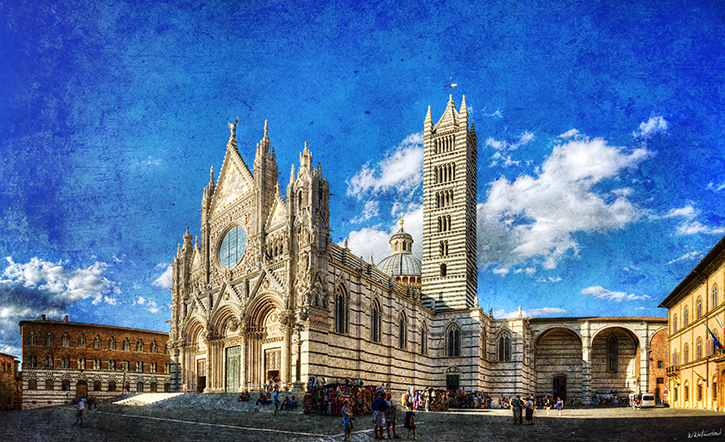
The Duomo de Siena, an unfinished business. The gate to the other side of the street is the darkened one on the arches to the right. (click to enlarge).
It was not to be. The Sienese finished what they could and the result is a nevertheless awe-striking structure that holds unexpected treasures such as the gate that leads nowhere you can see below. What was to be a gate into the church turned into a doorless gate from the piazza to a different street.
The Fiddler in the corner
And through that gate, I came across him. You can always tell when a great musician is playing somewhere. Artists create a silence around them, and the usual tourist chatter you could hear to one side of the gate died away at the other. Then you heard the fiddle wining with such delicacy it drew all your attention. The violinist, I later learned, was not just anyone. He is, or has been, a member of the City of Prague Philharmonic Orchestra. And you could tell right away.
The piece he was playing just pierced my soul. I couldn’t move. It was so beautiful and sad I felt my throat tighten. It was as though he knew how I felt and was playing for me. I listened to a couple of pieces, something I seldom do, and then left. He wasn’t there when I came back and I walked away with a touch of nostalgia.
I wandered back to the Campo, climbed the stairs to the very top, came back down and returned to the Duomo, as I wanted to get inside. And there he was again, this time at the other side of the archway. I listened for a while and he happened to play the same piece again. When he finished I asked him if that theme was included in the CD he was selling and he told me it was, so I bought it. First time ever I buy from a street player.
With the CD on my backpack I visited the inside of the Duomo, which is, to say the least, amazingly spectacular. Regretfully, it is also dark and tricky to shoot, so I still have not edited any pic I consider worth displaying for sale (I have a new camera, but used the old tripod and alas it was not up to the task in longish exposures). I will post this one, though, so you can get an idea of what I am talking about…

Main nave of the Duomo in Siena. Unfinished image.
Cheat, redemption and a forgotten composer
When I left Siena, I played the CD on my car on the way back to Florence. The piece that had so touched me was not there… I dedicated a rather long list of epithets and curses to the musician which I shall not reproduce here (XD) and have not listened to the CD again since. It was a compilation of violin versions of famous soundtracks.
Once the journey ended and I was back at home I set to finding the violin piece. I knew nothing about it save the identity of the violinist I had heard playing it (ok, he was Milan Kurc). I tracked him, found him in YouTube, found him playing that same piece, but could not identify the title anywhere. I gave up and forgot about it.
Two months later, I created a slideshow with some of the shots I had taken on my days in Florence. When I thought about the soundtrack I realized only one piece would do. And I started looking again. I found an article in Italian that talked about this violinist and commented on a wonderful piece he used to play. In the end the violinist was quoted: “it is an Ave Maria, but not Bach’s. It’s Caccini’s”. Gotcha! I learned about Cacinni, an Italian composer who died in Florence in 1618 and then learned that that Ave Maria was not actually his. It was Vladimir Vavilov’s. Vavilov composed this beauty in the 1970’s and registered it as anonymous. Then, in order to give it more resonance, he attributed it to Caccini. Vavilov died in poverty without learning of the amazing respect and success his piece would achieve. So the least we can do, when we hear his wonderful play is to tell everybody this is not Caccini’s Ave Maria. It is Vavilov’s!
So, here is my little slideshow with Vavilov’s Ave Maria as a soundtrack. I would suggest to watch it on a big screen with speakers in order to enjoy the images and the music at their best. Hope you like both…
Next post: Cinque Terre.
Ta-ta…
About the Pictures
I got a new camera this winter. I now shoot with a Sony ILCE-6000, or Alpha-6000 which is an absolutely delightful machine. All you are seeing here is HDR. The panoramas are huge photo-merged sequences, and most of them can be printed at over 100″. I have produced two versions of each picture, one vintage textured, the other untextured. The big panoramas have duet and triptych split versions too. Hope you like them. All those images and many more of this Lone Travel can be seen in my Gallery of Florence.
My pictures can be printed in photo paper, canvas, metal or acrylic surface up to 108″ in many cases, or in greeting card format. They also make wonderful duvet covers, throw pillows, iPhone cases… And I am all in for customizing pictures. Ask freely.








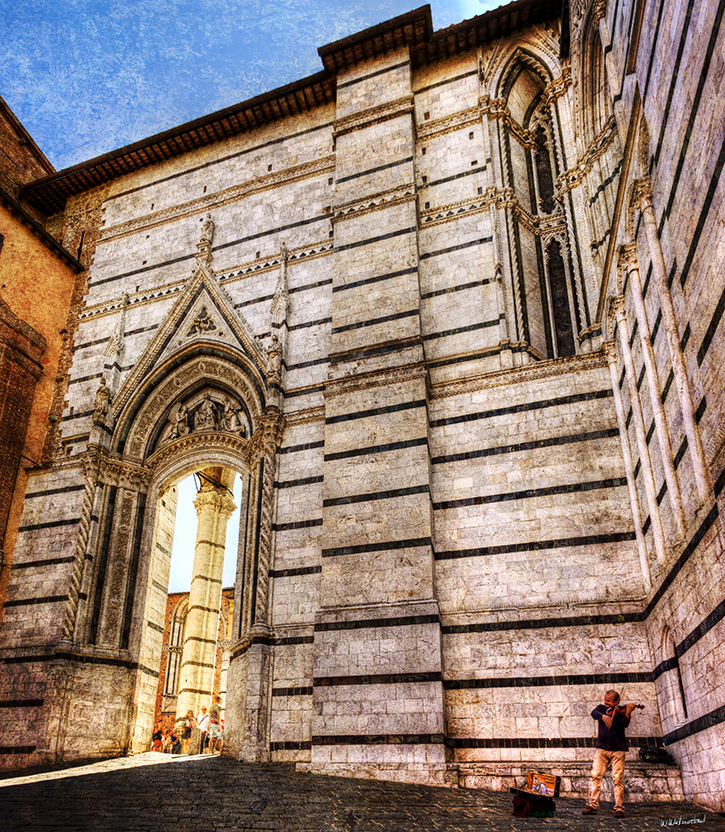
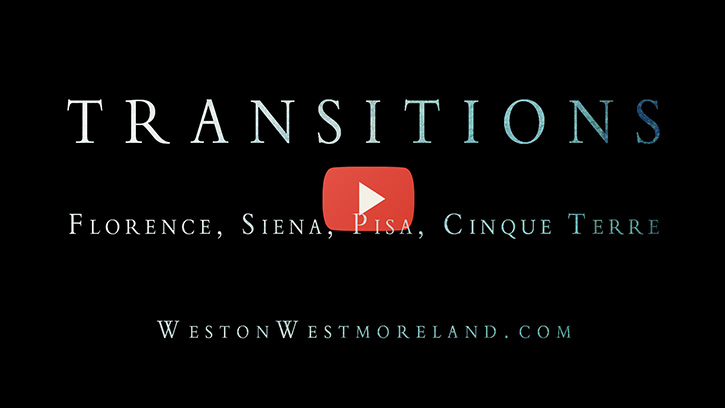
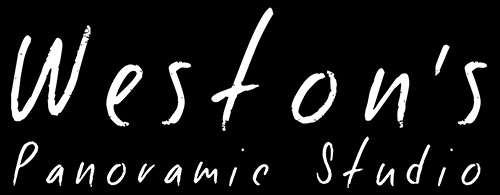
Sie-haben einen fantastischen Blog Dank. Cayla Hillier Shipp
¡Qué bueno es volver a leerte!
La música de violín tiene algo especial; puede tocarte en lugares profundos y sensibles.
Hermosas imágenes.
Saludos.
Hola guapa 🙂 a ver si cojo algo de ritmo otra vez…
Si, el violín tiene algo. Yo soy más bien rockanrolero, pero de siempre me ha resultado un instrumento que me pone la piel de gallina como ningún otro cuando da con la melodía adecuada. No sé de estas cosas y no sabría decir a qué se debe, pero parece que a mucha gente le pasa igual, así que algo sin duda tiene… y yo me alegro de poder, por lo menos, apreciarlo 🙂